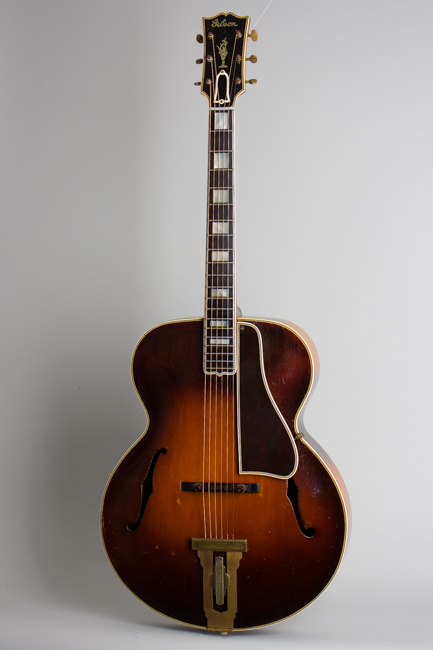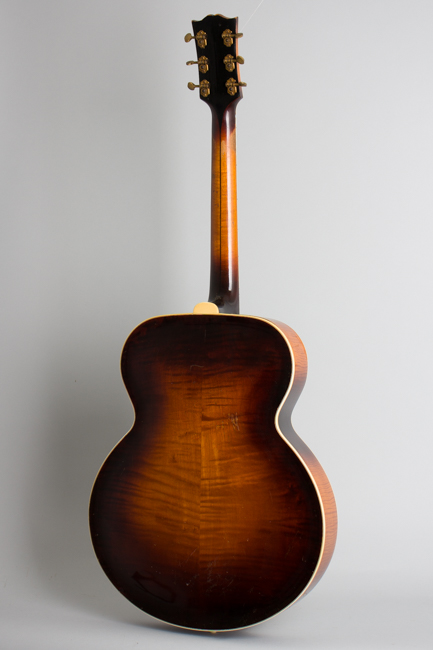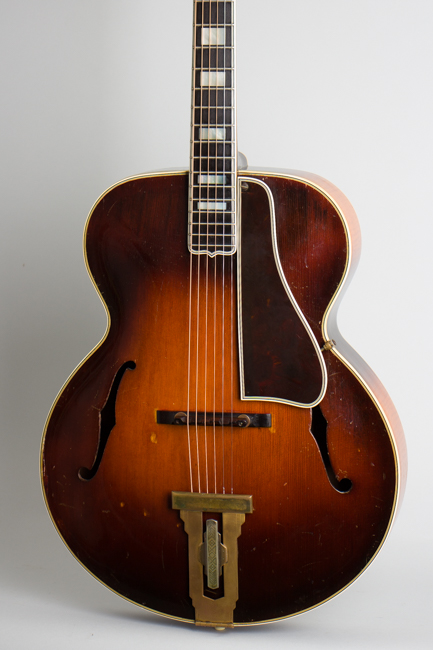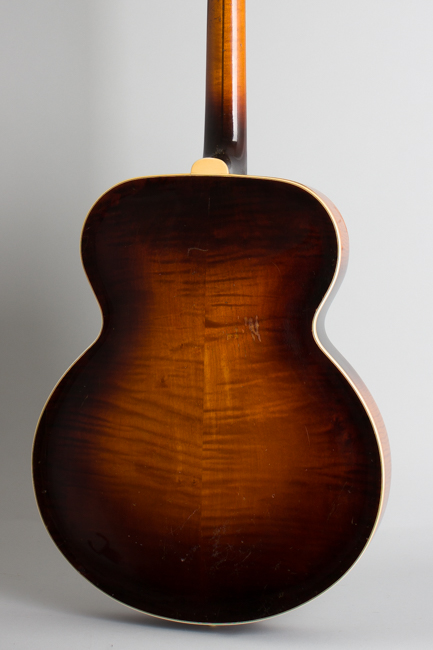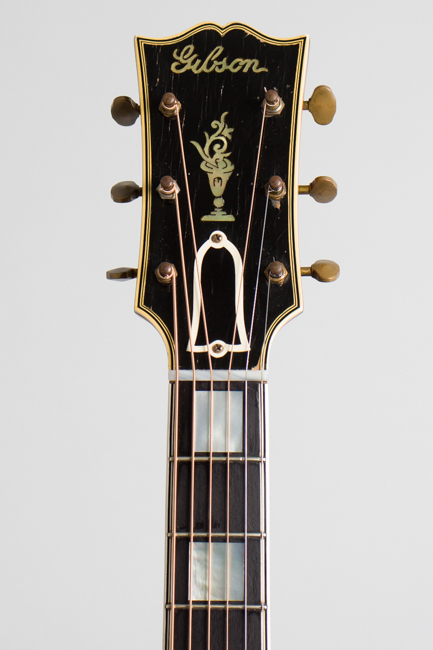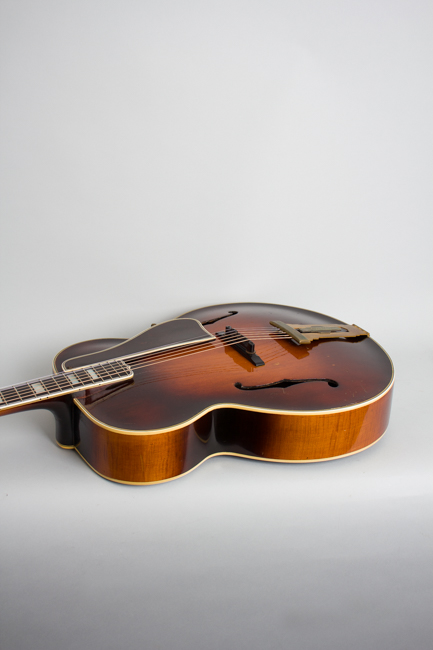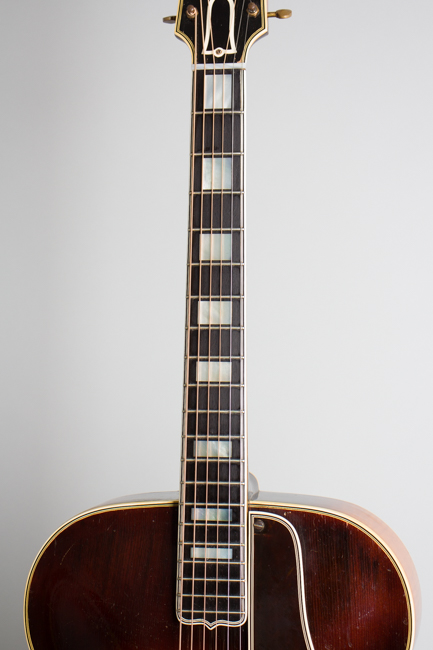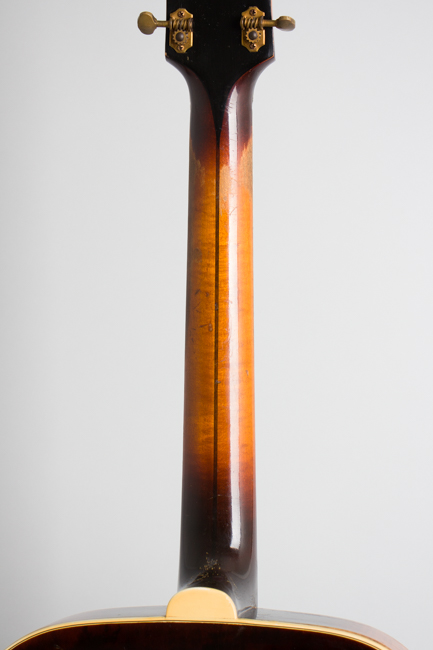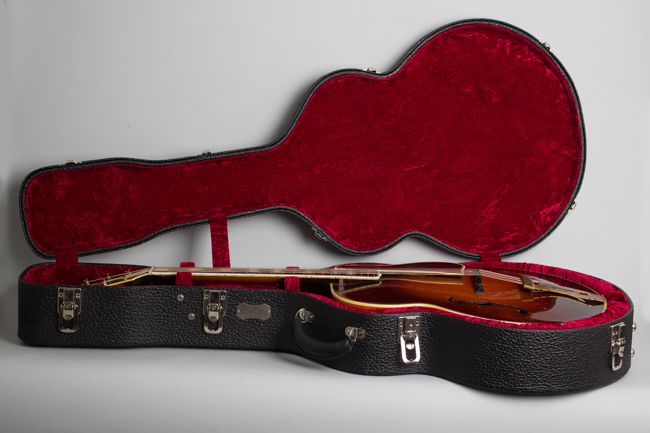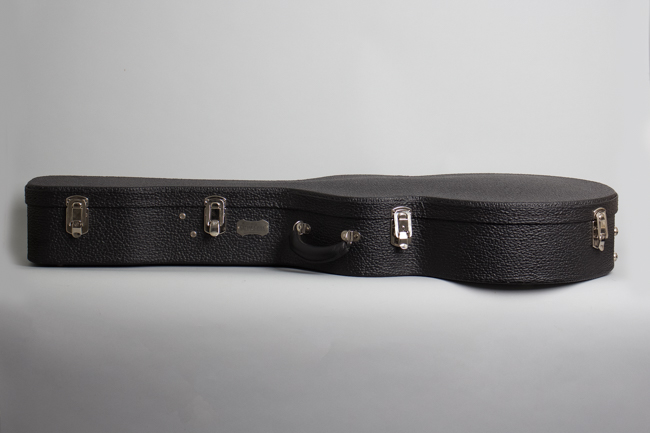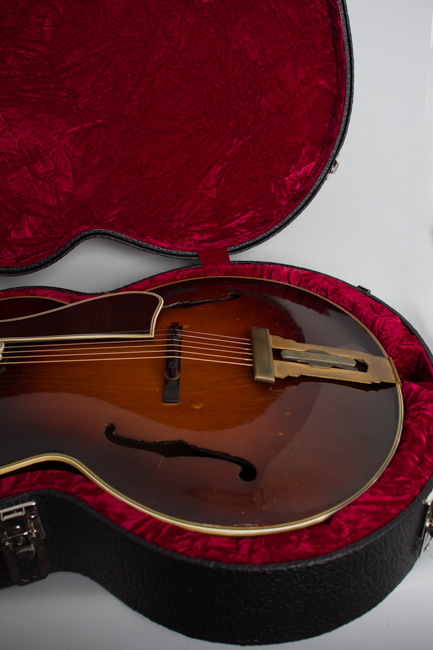Gibson L-5 Arch Top Acoustic Guitar (1936)
This item has been sold.
Item # 11608
Prices subject to change without notice.
Gibson L-5 Model Arch Top Acoustic Guitar (1936), made in Kalamazoo, Michigan, sunburst lacquer finish, maple body and neck, spruce top, rosewood fingerboard, black tolex hard shell case.
This is a well-played and great sounding early "Advanced" L-5 from the mid-1930's. In late 1934, under pressure from Epiphone Gibson upsized and upgraded their archtop guitar line. At the time the L-5 was supplanted at the very top by the new 18" Super 400, but in many ways it remained the company's signature instrument.
The newer 17" wide L-5 was bigger and fancier all around than the original 16" version, with extra layers of trim everywhere. It quickly became the keynote guitar for swing-era big band players, as well as radio and recording soloists like Dick McDonough and Carl Kress. Despite its prominence at the time this can now be a surprisingly hard-to-find guitar today.
Surviving data indicates that very few L-5's were actually produced in 1936...only 19 17" L-5's are listed as having shipped that year. While the records may well be incomplete, this does suggest that these guitars are rarer than generally thought. This L-5 has a serial number dating to early-mid 1936 which is confirmed by the "447B" Factory Order Number.
One unusual feature of these early advanced models is the top is "X" braced instead of the twin parallel braces used both earlier and later. The top carve is flatter than the earlier style, and the result is a slightly mellower sounding guitar than most comparable swing era archtops. Many players of the time were more concerned with having the "cut" to drive a big band, so Gibson reverted to parallel bracing in 1939. That these early advanced archtops the only vintage guitars from Kalamazoo with this subtly different character, which John D'Angelico soon adopted as his standard.
Typical L-5 appointments abound, including multiple binding everywhere, pearl flowerpot inlay, prewar script Gibson logo, wide bell truss rod cover, and pearl block position marks. The f-holes are unbound like the earlier smaller style. The sunburst finish is darler and subtler than many later examples, with a deep ruddy look. The tuners are the early style open-back gold plated Grovers while the tailpiece is the second pattern, still hinged at the base but with the contrasting silver-plated insert added.
This L-5 has seen some serious use but remains in excellent playing shape. The neck has a round-backed profile, thicker than some but not overly chunky. The guitar has obviously been played but well cared for over the last almost 80 years. Almost any style of play brings forth a big, powerful sound from this true veteran guitar.
Overall length is 42 1/2 in. (108 cm.), 17 1/16 in. (43.3 cm.) wide at lower bout, and 3 3/8 in. (8.6 cm.) in depth, measured at side of rim. Scale length is 24 3/4 in. (629 mm.). Width of nut is 1 5/8 in. (41 mm.).
This guitar shows some noticeable play wear but remains largely original. The finish has general wear overall, particularly to the back with checking, dings, scrapes and scratches. The top has some small touch ups, and may have has a thin lacquer overspray many decades ago. The back of the neck is fairly well worn down on the treble side, with some thumbwear on the bass side down by the nut. The headstock finish is fairly well checked.
There is a strap button hole patched on the heel. The back/side seam on the upper bass bout has been resealed, the repair was not lined up exactly but is solid. There are no other detectable cracks or seam repairs. All hardware remains original except for two of the tuner grommets, the correct general style but later and not gold plated. The bound celluloid pickguard appears original but the mounting block at the fore end has been reworked. The frets are the original style but appear to be a very old refret; they show only minor subsequent wear. This is a fine playing guitar with a big smooth sound, housed in a high-grade modern Cedar Creek HSC. Overall Excellent - Condition.
This is a well-played and great sounding early "Advanced" L-5 from the mid-1930's. In late 1934, under pressure from Epiphone Gibson upsized and upgraded their archtop guitar line. At the time the L-5 was supplanted at the very top by the new 18" Super 400, but in many ways it remained the company's signature instrument.
The newer 17" wide L-5 was bigger and fancier all around than the original 16" version, with extra layers of trim everywhere. It quickly became the keynote guitar for swing-era big band players, as well as radio and recording soloists like Dick McDonough and Carl Kress. Despite its prominence at the time this can now be a surprisingly hard-to-find guitar today.
Surviving data indicates that very few L-5's were actually produced in 1936...only 19 17" L-5's are listed as having shipped that year. While the records may well be incomplete, this does suggest that these guitars are rarer than generally thought. This L-5 has a serial number dating to early-mid 1936 which is confirmed by the "447B" Factory Order Number.
One unusual feature of these early advanced models is the top is "X" braced instead of the twin parallel braces used both earlier and later. The top carve is flatter than the earlier style, and the result is a slightly mellower sounding guitar than most comparable swing era archtops. Many players of the time were more concerned with having the "cut" to drive a big band, so Gibson reverted to parallel bracing in 1939. That these early advanced archtops the only vintage guitars from Kalamazoo with this subtly different character, which John D'Angelico soon adopted as his standard.
Typical L-5 appointments abound, including multiple binding everywhere, pearl flowerpot inlay, prewar script Gibson logo, wide bell truss rod cover, and pearl block position marks. The f-holes are unbound like the earlier smaller style. The sunburst finish is darler and subtler than many later examples, with a deep ruddy look. The tuners are the early style open-back gold plated Grovers while the tailpiece is the second pattern, still hinged at the base but with the contrasting silver-plated insert added.
This L-5 has seen some serious use but remains in excellent playing shape. The neck has a round-backed profile, thicker than some but not overly chunky. The guitar has obviously been played but well cared for over the last almost 80 years. Almost any style of play brings forth a big, powerful sound from this true veteran guitar.
Overall length is 42 1/2 in. (108 cm.), 17 1/16 in. (43.3 cm.) wide at lower bout, and 3 3/8 in. (8.6 cm.) in depth, measured at side of rim. Scale length is 24 3/4 in. (629 mm.). Width of nut is 1 5/8 in. (41 mm.).
This guitar shows some noticeable play wear but remains largely original. The finish has general wear overall, particularly to the back with checking, dings, scrapes and scratches. The top has some small touch ups, and may have has a thin lacquer overspray many decades ago. The back of the neck is fairly well worn down on the treble side, with some thumbwear on the bass side down by the nut. The headstock finish is fairly well checked.
There is a strap button hole patched on the heel. The back/side seam on the upper bass bout has been resealed, the repair was not lined up exactly but is solid. There are no other detectable cracks or seam repairs. All hardware remains original except for two of the tuner grommets, the correct general style but later and not gold plated. The bound celluloid pickguard appears original but the mounting block at the fore end has been reworked. The frets are the original style but appear to be a very old refret; they show only minor subsequent wear. This is a fine playing guitar with a big smooth sound, housed in a high-grade modern Cedar Creek HSC. Overall Excellent - Condition.
